- 1910s: Early Wristwatches
- Inter-War: Consolidation and Specialization
- Post-War: Automatic, Thin, and Complicated
- 1960s: New Movement Technology
- 1970s: The Rise of Quartz
- 1980s: Re-Birth of Mechanical Movements
1873
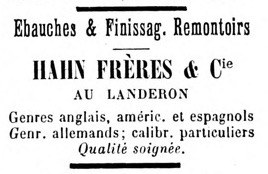
- Charles Hahn & Cie is established in Le Landeron
1882
- Edouard Heuer begins series production of chronographs in Bienne
1884
- Alfred Lugrin establishes his workshop (later called Lemania) in l’Orient-de-l’Orbe in the Vallée-de-Joux
1891
- Stolz Frères SA (later known as Angelus) is founded in Le Locle
1892
- Léon Breitling establishes the Montbrillant factory in La Chaux-de-Fonds, focusing on complicated watches including chronographs
1896
- Léon Lévy et Frères establishes a factory in Moutier, which would become home to Pierce
1901
- Reymond Frères SA, the predecessor to Valjoux, is established in Les Bioux
1906
- Lugrin & Cie. registers the Lemania name for repeating watches
1910
- Valjoux introduces Cal. 1, a 19 ligne monopusher chronograph movement, and Cal. 2 BR, a 19 ligne rattrapante chronograph movement
- Valjoux moves into a larger factory in Les Bioux
1910s: Early Wristwatches
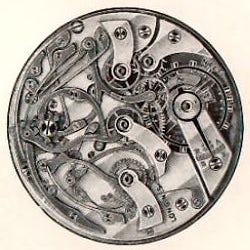
1911
- Valjoux introduces Cal. 18, a 17.675 ligne monopusher chronograph movement, and Cal. 20, a rattrapante movement, in the early 1910s
1913
- A variety of chronograph wristwatches appear on the market from Henchoz Fils, Ed. Heuer, Samuel Jeanneret (Colombe), and Nathan Weil.
- Longines releases the first chronograph wristwatch using Cal. 13.33Z, a 13 ligne monopusher chronograph movement
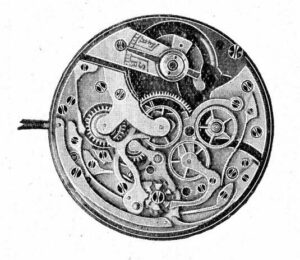
1914
- Valjoux introduces a 15 ligne column wheel chronograph movement, later called Cal. 22, which would be revised with 2 pushers in the 1930s and remain in production through the 1960s
- Georges Pellaton-Steudler establishes a factory in Les Pontes-de-Martel to produce complicated movements
1916
- Valjoux introduces Cal. 23 VZ, a 13 ligne chronograph used by Breitling in wristwatches in the Valjoux 72 family
- Valjoux introduces the 13 ligne Cal. 23C, a triple-date chronograph in the Valjoux 72 family
- The Martel factory introduces the 16.75 ligne “6:00 monopusher” chronograph movement used in the first Universal chronograph wristwatch
1917
- Perret et Berthoud of Le Locle introduces the first Universal-branded chronograph wristwatch, powered by a 16.75 ligne monopusher movement produced by Georges Pellaton’s factory in Les Ponts-de-Martel
1920
- The Martel factory introduces their 15.25 ligne co-axial monopusher chronograph movement used by Universal and others
1923
- Hahn in Landeron produce their first chronograph movements
Inter-War: Consolidation and Specialization
1924
- Fabrique d’Ébauches Vénus is founded in Moutier
- Lugrin & Cie. becomes Lemania Lugrin
1925
- Hahn Frères of Le Landeron merges with FHF
- The Martel factory introduces their 16 ligne monopusher chronograph movement
- Angelus produces their first chronograph wristwatch using Valjoux Cal. 23 VZ or Cal. 22
1926
- Ebauches SA is founded in Neuchâtel, containing A. Schild SA (ASSA) and Adolphe Michel SA (AMSA) of Grenchen and Fabrique d’Horlogerie de Fontainemelon (FHF)
1931
- Eugène Meylan’s Automatic E.M.S.A. movement ring enters production by Glycine
1932
- The Martel factory introduces their 14.5 ligne monopusher chronograph movement; it would be modified for 2-button operation over the next two years for use in the earliest Universal Compur chronograph watches
- Lemania, Omega, and Tissot form SSIH
- Lemania releases Cal. 13CH (Omega Cal. 28.9), a 13 ligne monopusher column wheel chronograph movement used in the first compact Omega chronograph wristwatches
1933
- Vénus introduces their first chronograph movement, Cal. 103 CHR, a simple 10.5 ligne stopwatch
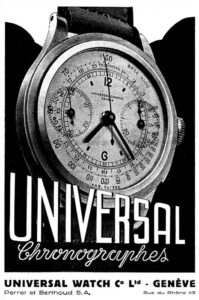
1934
- The Universal Compur 2-button chronograph wristwatch is released for sale, using a modified version of the 14.5 ligne chronograph movement produced by the Martel factory
- In late 1934 Universal updates the Compur with a revised movement, Cal. 285, from the Martel factory
1935
- Vénus introduces Cal. 140, a monopusher chronograph with time at 12:00 and 30-minute counter at 6:00
- Léon Lévy Frères’ Pierce Watch Co. patents the vertical clutch chronograph, which entered production the following year
- Lemania introduces Cal. 33.3, a monopusher chronograph movement used by Omega and Tissot over the next decade
- Angelus introduces their first 2-pusher chronograph, which uses their in-house Cal. SF210
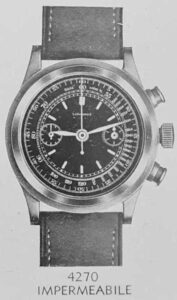
1936
- Universal introduces the Uni-Compax watch, based on the new Cal. 281 movement produced at the Martel factory
- Vénus patents Cal. 131 CHR, a tonneau-shaped chronograph movement
- Vénus introduces Cal. 170, a 2-button chronograph with small seconds at 6:00 and 3 minute counter at 12:00
- Valjoux revises Cal. 22 with two pushers
- Longines introduces Cal. 13ZN, a 13 ligne monopusher or 2-button chronograph movement
- Hahn in Landeron introduces Cal. 47, a 3-pusher cam-operated chronograph movement
- Bovet Frères introduces their “mono-rattrapante”, a simplified flyback chronograph movement using Valjoux Cal. 84
1937
- Universal introduces the Compax, with a 12-hour counter at 6:00, using Cal. 285 produced by Martel
- Universal introduces the ladies Compur, using the compact 12.5 ligne Cal. 289 produced by Martel
- Hahn in Landeron introduces Cal. 48, a 2-pusher cam-operated chronograph movement
- Nicolet Watch SA is established in Tramelan as a successor to the Nicolet watchmaking family dating back to the 1880s
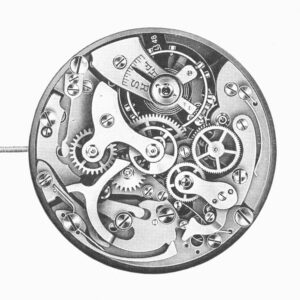
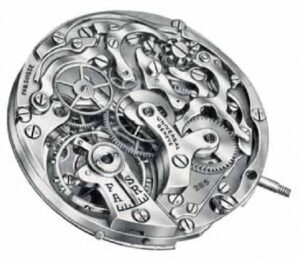
1938
- The Vénus Cal. 150 family is in production, an integrated 13 ligne 2-button chronograph which was possibly introduced as early as 1936
- Valjoux introduces Cal. 71 GHH, which adds a 12-hour counter to the Cal. 22 chronograph
- Valjoux introduces Cal. 72VZH, which adds a 12-hour counter to the 13 ligne Cal. 23 chronograph
1939
- Pierce Watch Co. introduces the first 2-button vertical clutch chronograph watch
- Nicolet Watch introduces a 2-button chronograph movement
1940
- Universal introduces the Aero-Compax, with a manually-operated hour and minute hand at 12:00 on the 3-register Cal. 287
1942
- Vénus introduces Cal. 152 (with hour counter at 6:00) and the Cal. 175 family including Cal. 179 (a rattrapante), though the latter took a few years to reach production
- Between 1942 and 1945, every Landeron-powered watch Breitling’s catalog was replaced by a new model using a Vénus movement
- Lemania introduces Cal. 27 CHRO C12 (later called Cal. 2310), a column wheel chronograph movement with hour counter used by Omega as Cal. 321
- Angelus introduces the Chronodato with Cal. SF217
1943
- The Breitling Duograph with Vénus Cal. 179 rattrapante chronograph is in production and on sale
- Universal introduces the Montre-Calendrier, a hand-winding perpetual calendar watch with optional moon phase display
1944
- Universal introduces the Tri-Compax, a triple-date moon phase chronograph powered by Martel’s Cal. 481
- Valjoux is incorporated into Ebauches SA
1945
- Universal introduces the Medico-Compax for doctors (with Cal. 285) and Dato-Compax with date at 12:00 (with Cal. 285)
Post-War: Automatic, Thin, and Complicated
1946
- Albert Piguet of Lemania creates Cal. 321 for Omega
1947
- Hahn in Landeron updates their cam-operated chronograph line as Cal. 51
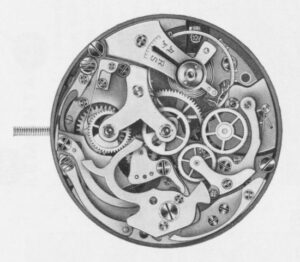
1948
- Vénus introduces Cal. 188, a 2-button cam-operated chronograph movement
1949
- Vénus adds calendar and moon phase functions to their chronograph movements, including Cal. 190 (rattrapante and moon phase)
1950
- Vénus adds a calendar to their cam-operated Cal. 188 chronograph
1953
- Vénus reduces the diameter of Cal. 188, resulting in the 12.5 ligne Cal. 210, a cam-operated chronograph movement
1954
- Valjoux introduces Cal. 230, a 13 ligne flyback chronograph in the Valjoux 72 family
1955
- Vénus introduces the first “big date” chronograph movement, Cal. 211, in the mid 1950s
1958
- Ebauches SA stops enforcing restrictions on watch movement production
- The Büren “Super Slender” and Universal “Microtor” movements with micro-rotor automatic winding are introduced
1959
- The First Moscow Watch Factory (Poljot) is producing the “Strela” with Cal. 3017, a copy of Vénus Cal. 150
1960s: New Movement Technology
1961
- Lemania introduces Cal. 1872, a hand-winding cam-switching chronograph movement
1962
- Büren introduces Cal. 1281, their next-generation micro-rotor automatic movement
1963
- Tianjin Sea-Gull introduces the first prototypes of Cal. 1901, a chronograph based on the Vénus 175 design
1966
- The Vénus operation in Moutier becomes part of Valjoux and the company re-launches Vénus Cal. 210 with a mobile stud carrier as Valjoux Cal. 7730
1967
- Valjoux (Vénus) introduces Cal. 7731 with a new balance and balance cock
1968
- Ebauches SA introduces the Mosaba tuning fork movement line with Cal. ESA 9160
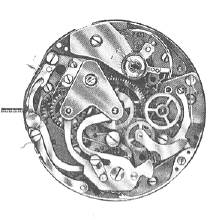
1969
- Zenith introduces the El Primero automatic chronograph developed by their subsidiary, Martel, on January 10
- Breitling, Heuer, and Hamilton-Büren introduce the Chronomatic automatic chronograph on March 3
- The Seiko Speed Timer Ref. 6139 automatic chronograph is in production by March
- Valjoux (Vénus) introduces Cal. 7733 and Cal. 7734 (with calendar)
- Ebauches SA introduces the tuning fork Cal. ESA 9162 (with date)
1970s: The Rise of Quartz
1971
- The workhorse ETA 2800 family is introduced
1972
- Valjoux introduces Cal. 7740
- Ebauches SA introduces two tuning fork movements: Cal. ESA 9210 (the first electronic chronograph movement) and Cal. ESA 9164 (with day and date)
- Lemania introduces Cal. 1340, an automatic cam-switching chronograph movement with hour counter and date
1974
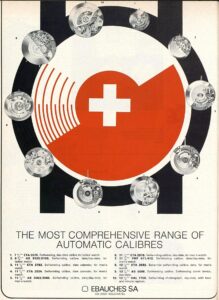
- Valjoux begins productions of Cal. 7750, an integrated automatic cam-switching chronograph movement
- Production of the Valjoux 7730 series ends; the First Moscow Watch Factory (Poljot) is producing Cal. 3133, a copy of Valjoux (Vénus) Cal. 7734, in 1975
- Lemania introduces Cal. 5100, an automatic cam-switching chronograph movement with hour counter, 24 hour hand, and day/date
1975
- ETA introduces the “Flatline” 2890 Family of movements (designed by Anton Bally) at 12.5 ligne (28.0 mm) diameter
1977
- Production of the Valjoux 7750 ends
1978
- Production of the El Primero by Zenith ends, with the tooling stored in the attic at the company’s headquarters
1980s: Re-Birth of Mechanical Movements
1982
- Nouvelle Lemania is brought under Groupe Horloger Breguet after being spun out of SSIH the year before
- ETA revises the workhorse 2800 Family of movements, including Cal. 2824-2 and Cal. 2836-2
1983
- Lemania introduces Cal. 1883, a cam-switching chronograph movement with moon phase
- ETA reduces the diameter of the 2890 Family to 11.5 ligne (25.60 mm)
1985
- IWC introduces Kurt Klaus’ Da Vinci automatic perpetual calendar chronograph
1986
- Zenith restarts production of the El Primero automatic chronograph, now known as Cal. 40.0
1987
- F. Piguet introduces Cal. 1180, an ultra-thin chronograph movement
1988
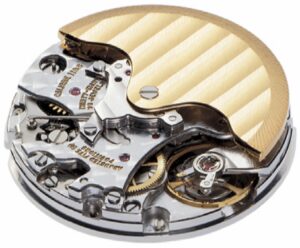
- F. Piguet introduces Cal. 1185, an ultra-thin automatic chronograph movement
1989
- F. Piguet introduces an ultra-thin automatic rattrapante chronograph movement for Blancpain, which would be released as Cal. 1186 for other makers in 1994
1992
- ETA introduces the 2893 travel time movements
1994
- Lemania introduces Cal. 1350, an automatic cam-switching chronograph movement
- Zenith introduces the Elite family of automatic movements
1996
- ETA introduces Cal. 2894-2, a compact automatic chronograph movement
- ETA introduces Cal. 2892A2
2003
- ETA introduces the compact 10.5 ligne Cal. 2094, an automatic chronograph movement based on Cal. 2004-1
2004
- ETA introduces the “big date” Cal. 2826-2